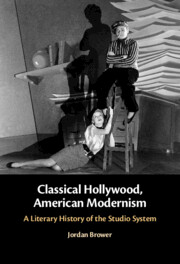Book contents
- Classical Hollywood, American Modernism
- Classical Hollywood, American Modernism
- Copyright page
- Dedication
- Contents
- Figures
- Acknowledgments
- Introduction
- Chapter 1 Paramount Pictures and Transmedial Possibility
- Chapter 2 MGM Modernism
- Chapter 3 The Motion Picture Industry’s Coming of Age
- Chapter 4 Global Hollywood
- Chapter 5 The Scenes of an Ending
- Chapter 6 Conclusion
- Notes
- Index
Chapter 1 - Paramount Pictures and Transmedial Possibility
Published online by Cambridge University Press: 04 January 2024
- Classical Hollywood, American Modernism
- Classical Hollywood, American Modernism
- Copyright page
- Dedication
- Contents
- Figures
- Acknowledgments
- Introduction
- Chapter 1 Paramount Pictures and Transmedial Possibility
- Chapter 2 MGM Modernism
- Chapter 3 The Motion Picture Industry’s Coming of Age
- Chapter 4 Global Hollywood
- Chapter 5 The Scenes of an Ending
- Chapter 6 Conclusion
- Notes
- Index
Summary
In the early 1910s, the extension of copyright protection to moving picture adaptations of literary works resulted in the emergence of film rights, and this phenomenon had a profound effect on film production and the writing of fiction. Paramount Studios, originally the Famous Players-Lasky Corporation, became the most powerful studio of the 1910s and 1920s, in part, due to its unparalleled ability to exploit preexisting literary and dramatic properties: to produce “Famous Plays with Famous Players.” At the same time, this new regime altered the constitution of the American literary field. Authors and studios alike reflected on the importance of preparing fiction for eventual adaptation. I call the capacity for authors to imagine the afterlives of their prose works before writing the “transmedial possibility” of fiction. This possibility influenced the work of several writers who published in American modernism's great year 1925, all of whom responded in some way to Paramount: Anita Loos’s Gentlemen Prefer Blondes, John Dos Passos’s Manhattan Transfer, F. Scott Fitzgerald’s The Great Gatsby, and Theodore Dreiser's An American Tragedy.
Keywords
- Type
- Chapter
- Information
- Classical Hollywood, American ModernismA Literary History of the Studio System, pp. 21 - 53Publisher: Cambridge University PressPrint publication year: 2024

